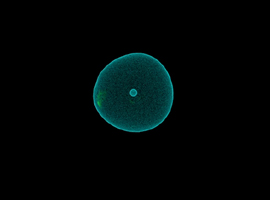
Click the image to play the animationNuSTAR has provided the first observational evidence in support of a theory that says exploding stars slosh around before detonating. That theory, referred to as mild asymmetries, is shown here in a simulation by Christian Ott of the California Institute of Technology, Pasadena.
In this simulation, a supernova explosion is already underway. The small circle in the center represents the material that will form the dense star at the center of a supernova remnant, called a neutron star. The bright ring surrounding it is the shock wave created in the explosion. The colors represent temperature fluctuations. When the movie starts, the explosion has "stalled out," because the material falling back onto the neutron star has backed up, like too many cars on the freeway, blocking the shock wave from progressing.
As the explosion continues, material starts to slosh around, reenergized by particles called neutrinos. The neutrinos heat up the material more and more, causing the hot regions to rise into the cooler regions and form large bubbles in the material. Once the bubbles break through the surrounding material, it's as if the top of a pressure cooker blows off. There's nothing holding back the shock wave any more and the star explodes.
NuSTAR is a Small Explorer mission led by the California Institute of Technology in Pasadena and managed by NASA's Jet Propulsion Laboratory, also in Pasadena, for NASA's Science Mission Directorate in Washington. The spacecraft was built by Orbital Sciences Corporation, Dulles, Va. Its instrument was built by a consortium including Caltech; JPL; the University of California, Berkeley; Columbia University, N.Y.; NASA's Goddard Space Flight Center, Greenbelt, Md.; the Danish Technical University in Denmark; Lawrence Livermore National Laboratory, Livermore, Calif.; ATK Aerospace Systems, Goleta, Calif., and with support from the Italian Space Agency (ASI) Science Data Center, Rome, Italy.
NuSTAR's mission operations center is at UC Berkeley, with ASI providing its equatorial ground station located at Malindi, Kenya. The mission's outreach program is based at Sonoma State University, Rohnert Park, Calif. NASA's Explorer Program is managed by Goddard. JPL is managed by Caltech for NASA.
For more information, visit http://www.nasa.gov/nustar and http://www.nustar.caltech.edu/.

